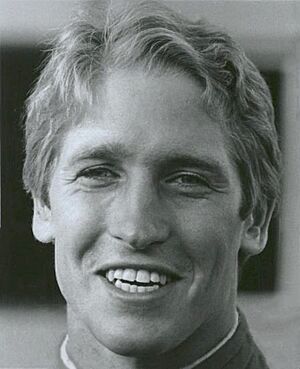Bill Johnson (skier) facts for kids
| Alpine skier | ||||||||||||||

Johnson in 1984
|
||||||||||||||
| Disciplines | Downhill, Super G, Combined | |||||||||||||
|---|---|---|---|---|---|---|---|---|---|---|---|---|---|---|
| Born | March 30, 1960 Los Angeles, California, U.S. |
|||||||||||||
| Died | January 21, 2016 (aged 55) Gresham, Oregon, U.S. |
|||||||||||||
| Height | 5 ft 9 in (175 cm) | |||||||||||||
| World Cup debut | February 5, 1983 (age 22) | |||||||||||||
| Retired | March 1990 (age 30) | |||||||||||||
| Olympics | ||||||||||||||
| Teams | 1 – (1984) | |||||||||||||
| Medals | 1 (1 gold) | |||||||||||||
| World Championships | ||||||||||||||
| Teams | 1 – (1985) | |||||||||||||
| Medals | 0 | |||||||||||||
| World Cup | ||||||||||||||
| Seasons | 8 – (1983–1990) | |||||||||||||
| Wins | 3 – (3 DH) | |||||||||||||
| Podiums | 3 – (3 DH) | |||||||||||||
| Overall titles | 0 – (14th in 1984) | |||||||||||||
| Discipline titles | 0 – (3rd in DH, 1984) | |||||||||||||
|
Medal record
|
||||||||||||||
Bill Johnson (born March 30, 1960 – died January 21, 2016) was an amazing American ski racer. He made history at the 1984 Winter Olympics in Sarajevo. Bill was the first American man to win an Olympic gold medal in alpine skiing. He was also the first skier from outside the Alps mountains to win an Olympic downhill race!
Contents
Bill Johnson's Early Life and Olympic Win
Bill Johnson was born in Los Angeles, California, in 1960. When he was seven, his family moved to Boise, Idaho. He learned to ski at Bogus Basin. Later, they moved to Brightwood, near Mount Hood.
Bill found competitive skiing on Mount Hood. It helped him focus his energy. At age 17, he chose to attend a ski academy. This decision helped him join the United States Ski Team.
Becoming a World Cup Star
Bill Johnson started his World Cup career in February 1983. He quickly showed his skill in the downhill event. He finished sixth in a race in Austria.
In 1984, when Bill was 23, he began to challenge the top European skiers. These skiers had dominated downhill racing for a long time. Bill was known for being confident and outspoken.
He was even nicknamed "Billy the Kid." He once said that downhill skiers are daredevils. He loved going fast and taking risks.
Bill's first big win was on January 15, 1984. He won a World Cup downhill race in Wengen, Switzerland. This was the first time an American man had won a World Cup downhill event.
Sarajevo Olympic Gold
A month later, Bill went to the 1984 Winter Olympics in Sarajevo, Yugoslavia. He performed very well in his training runs. The course suited his fast, gliding style.
Bill boldly predicted he would win the Olympic gold medal. This surprised many of his European rivals. He won the downhill race at Bjelašnica. His time was 1:45.59.
He beat Peter Müller of Switzerland by 0.27 seconds. After his victory, he was asked what the win meant to him. He famously said, "Millions, man, we're talkin' millions!" He later explained this was about the prize money, not the personal meaning.
Life After the Olympics
After his Olympic win, Bill continued his success. He won two more World Cup downhill races in March 1984. These wins were in Aspen and Whistler.
In just two months, he had four downhill victories. He was an Olympic champion. He finished third in the downhill standings for the 1984 season.
Challenges and Injuries
After 1984, Bill's results were not as strong. His best finishes were two 7th places. One was in Wengen in 1985, and another in Whistler in 1986.
He faced some challenges with the U.S. Ski Team. He was late to a training camp once. His funding was temporarily stopped in 1985.
Bill also suffered injuries. He hurt his left knee in December 1986. He also had back surgery. Because of these injuries and lower performance, he was not chosen for the 1988 Winter Olympics.
He couldn't defend his gold medal. He was later suspended from the team. By 1990, he retired from competitive skiing.
Life Beyond Skiing
After his Olympic win, Bill shared his strong opinions. He talked about how ski racing should be run. He even tried to start a new professional ski circuit in 1985. However, it did not succeed.
In 1985, a TV movie was made about his Olympic journey. It was called Going for the Gold: The Bill Johnson Story. The actor Anthony Edwards played Bill.
Bill Johnson had two sons, Tyler and Nick. His personal motto was "Ski To Die." He even had it tattooed on his arm.
Comeback Attempt and Later Life
Bill faced a very sad time in 1992. His 13-month-old son, Ryan, drowned in a hot tub. This was a very difficult loss for him.
At age 40, Bill decided to try a comeback. He wanted to compete in the 2002 Winter Olympics in Salt Lake City. He was living in a motorhome at the time.
A Serious Accident
His comeback attempt ended suddenly on March 22, 2001. Bill crashed during a training run. This happened before a downhill race in Montana.
He suffered a serious brain injury. He was in a coma for three weeks. This accident changed his life forever.
In 2010, Bill lived in Zigzag, near Mount Hood. He still had brain damage and needed constant care. His speech and memory were permanently affected.
He later suffered a massive stroke. This happened in 2010. He moved to a care facility in Gresham. The stroke caused him to lose the ability to sit up on his own. He also lost the use of his right hand.
He lost sight in his left eye. He could only speak in a whisper. Eating was also very painful for him.
In June 2013, Bill got a serious infection. He was put on life support. In July, he chose to stop life support. He wanted to be allowed to die if something similar happened again.
He returned to long-term care in 2014. He was free of infection. He could move one side of his body. He could eat and smoke with help. He also communicated using a letter board. However, his health continued to get worse over the next two years.
Bill Johnson's Passing
Bill Johnson died on January 21, 2016. He was 55 years old. He passed away at the care facility in Gresham.
World Cup Results
Season Standings
| Season | Age | Overall | Slalom | Giant Slalom |
Super G | Downhill | Combined |
|---|---|---|---|---|---|---|---|
| 1983 | 22 | 65 | — | — | not awarded |
27 | 25 |
| 1984 | 23 | 14 | — | — | 3 | — | |
| 1985 | 24 | 57 | — | 49 | 24 | — | |
| 1986 | 25 | 41 | — | — | — | 20 | — |
| 1987 | 26 | (103) | injured in Dec 1986, out for season | ||||
| 1988 | 27 | (116) | no World Cup points | ||||
| 1989 | 28 | (103) | |||||
| 1990 | 29 | (108) | |||||
Points were only awarded for top 15 finishes.
Top Ten Finishes
- 3 wins – (3 DH)
- 3 podiums – (3 DH), 11 top ten finishes (11 DH)
| Season | Date | Location | Discipline | Place |
|---|---|---|---|---|
| 1983 | February 11, 1983 | Downhill | 6th | |
| 1984 | January 15, 1984 | |
Downhill | 1st |
| February 2, 1984 | Downhill | 4th | ||
| March 4, 1984 | Downhill | 1st | ||
| March 11, 1984 | Downhill | 1st | ||
| 1985 | January 19, 1985 | |
Downhill | 10th |
| January 20, 1985 | Downhill | 7th | ||
| 1986 | January 18, 1986 | Downhill | 8th | |
| February 7, 1986 | Downhill | 10th | ||
| February 21, 1986 | Downhill | 9th | ||
| March 15, 1986 | Downhill | 7th | ||
Source:
Olympic Results
| Year | Age | Slalom | Giant Slalom |
Super-G | Downhill | Combined |
|---|---|---|---|---|---|---|
| 1984 | 23 | — | — | not run | 1 | not run |
World Championship Results
| Year | Age | Slalom | Giant Slalom |
Super-G | Downhill | Combined |
|---|---|---|---|---|---|---|
| 1985 | 24 | — | — | not run | 14 | — |
Images for kids



